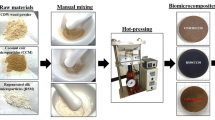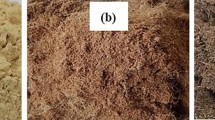Abstract
The lignin-cellulosic texture of wood was used to produce two-dimensional (2D) carbon/carbon (C/C) composites using coal tar pitch. Ash content tests were conducted to select two samples among the different kinds of woods present in Iran, including walnut, white poplar, cherry, willow, buttonwood, apricots, berry, and blue wood. Walnut and white poplar with ash contents of 1.994wt% and 0.351wt%, respectively, were selected. The behavior of these woods during pyrolysis was investigated by differential thermal analysis (DTA) and thermo gravimetric (TG) analysis. The bulk density and open porosity were measured after carbonization and densification. The microstructural characteristics of samples were investigated by scanning electron microscopy (SEM), X-ray diffraction (XRD), and Fourier-transform infrared (FT-IR) spectroscopy. The results indicate that the density of both the walnut and white poplar is increased, and the open porosity is decreased with the increasing number of carbonization cycles. The XRD patterns of the wood charcoal change gradually with increasing pyrolysis temperature, possibly as a result of the ultra-structural changes in the charcoal or the presence of carbonized coal tar pitch in the composite’s body.
Similar content being viewed by others
Explore related subjects
Discover the latest articles, news and stories from top researchers in related subjects.References
T. Manabe, M. Ohata, S. Yoshizawa, D. Nakajima, S. Goto, K. Uchida, and H. Yajima, Effect of carbonization temperature on the physicochemical structure of wood charcoal, Trans. Mater. Res. Soc. Jpn., 32(2007), No. 4, p. 1035.
T.C. Wang, T.X. Fan, D. Zhang, and G.D. Zhang, Fabrication and the wear behaviors of the carbon/aluminum composites based on wood templates, Carbon, 44(2006), No. 5, p. 900.
T.C. Wang, T.X. Fan, D. Zhang, and G.D. Zhang, Fabrication, thermal expansions, and mechanical properties of carbon/aluminum composites based on wood templates, J. Mater. Sci., 41(2006), No. 18, p. 6095.
Y. Ohzawa, M. Mitani, J.L. Li, and T. Nakajima., Structures and electrochemical properties of pyrolytic carbon films infiltrated from gas phase into electro-conductive substrates derived from wood, Mater. Sci. Eng. B, 113(2004), No. 1, p. 91.
I. Külaots, A. Hsu, and E.M. Suuberg, The role of porosity in char combustion, Proc. Combust. Inst., 31(2007), No. 2, p. 1897.
M. Kumar and R.C. Gupta, Influence of carbonization conditions on the pyrolytic carbon deposition in acacia and eucalyptus wood chars, Energy Sources, 19(1997), No. 3, p. 295.
G.A. Zickler, T. Schöberl, and O. Paris, Mechanical properties of pyrolysed wood: a nanoindentation study, Philos. Mag., 86(2006), p. 1373.
P. Colombo, Conventional and novel processing methods for cellular ceramics, Philos. Trans. R. Soc. A, 364(2006), No. 1838, p. 109.
V. Pancholi, D. Mallick, Ch. AppaRao, I. Samajdar, O.P. Chakrabarti, H.S. Maiti, and R. Majumdar, Microstructural characterization using orientation imaging microscopy of cellular Si/SiC ceramics synthesized by replication of Indian dicotyledonous plants, J. Eur. Ceram. Soc., 27(2006), p. 367.
P. Álvarez, C. Blanco, R. Santamaría, and M. Granda, Lignocellulose/pitch based composites, Compos. Part A, 36(2005), No. 5, p. 649.
Y.S. Virgil’ev and I.P. Kalyagina, Carbon-carbon composite materials, Inorg. Mater., 40(2004), No. 1, p. S33.
J.N. Sahu, J. Acharya, and B.C. Meikap, Optimization of production conditions for activated carbons from Tamarind wood by zinc chloride using response surface methodology, Bioresour. Technol., 101(2010), No. 6, p. 1974.
S.M. Kwon, N.H. Kim, and D.S. Cha, An investigation on the transition characteristics of the wood cell walls during carbonization, Wood Sci. Technol., 43(2009), No. 5–6, p. 487.
F.C. Beall and H.W. Elckner, Thermal degradation of wood components: a review of the literature, U.S.D.A. Forest Service Research Paper, U.S. Department of Agriculture, Forest Products Laboratory, Madison, 1970, p. 130.
W. Brostow, K.P. Menard, and N. Menard, Combustion properties of several species of wood, Chem. Chem. Technol., 3(2009), No. 3, p. 173.
S.X. Liu, S.R. Zhang, B.N. Li, and W.H. Zhu, Thermal testing methods in determination of characterization of charcoals, J. For. Res., 11(2000), No. 1, p. 60.
M. Klučáková, Analysis of relationship between properties and behaviour of materials used and impregnation conditions of carbon-carbon composites, Acta Mater., 53(2005), No. 14, p. 3841.
S.S. Tzeng and J.H. Pan, Densification of two-dimensional carbon/carbon composites by pitch impregnation, Mater. Sci. Eng. A, 316(2001), No. 1–2, p. 127.
K. Nishimiya, T. Hata, Y. Imamura, and S. Ishihara, Analysis of chemical structure of wood charcoal by X-ray photoelectron spectroscopy, J. Wood Sci., 44(1998), No. 1, p. 56.
T. Hirose, T. Fujino, T.X. Fan, E. Hiroyuki, T. Okabe, and M. Yoshimura, Effect of carbonization temperature on the structural changes of woodceramics impregnated with liquefied wood, Carbon, 40(2002), p. 761.
G.R. Devi and K.R. Rao, Carbon-carbon composites: an overview, Defence Sci. J., 43(1993), No. 4, p. 369.
Author information
Authors and Affiliations
Corresponding author
Rights and permissions
About this article
Cite this article
Esmaeeli, M., Khosravi, H. & Mirhabibi, A. Fabrication method and microstructural characteristics of coal-tar-pitch-based 2D carbon/carbon composites. Int J Miner Metall Mater 22, 210–216 (2015). https://doi.org/10.1007/s12613-015-1063-5
Received:
Revised:
Accepted:
Published:
Issue Date:
DOI: https://doi.org/10.1007/s12613-015-1063-5




